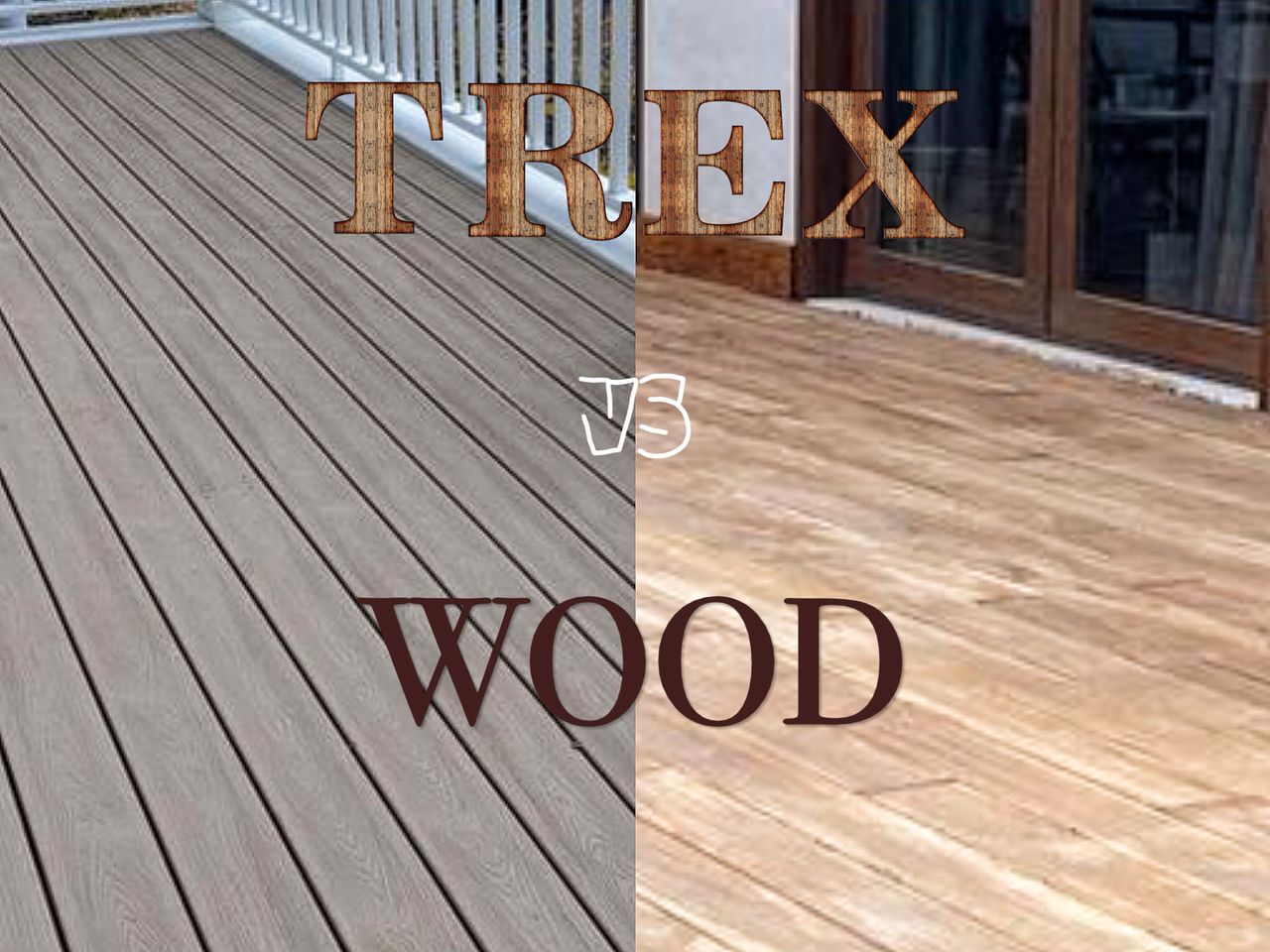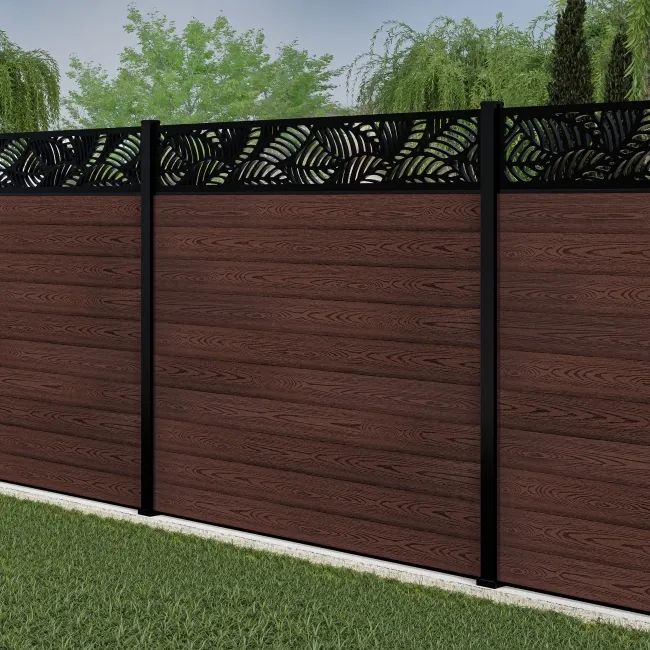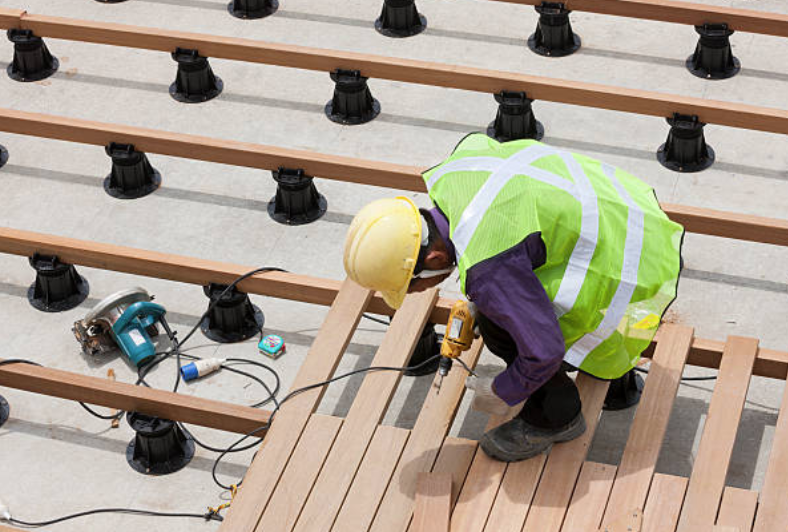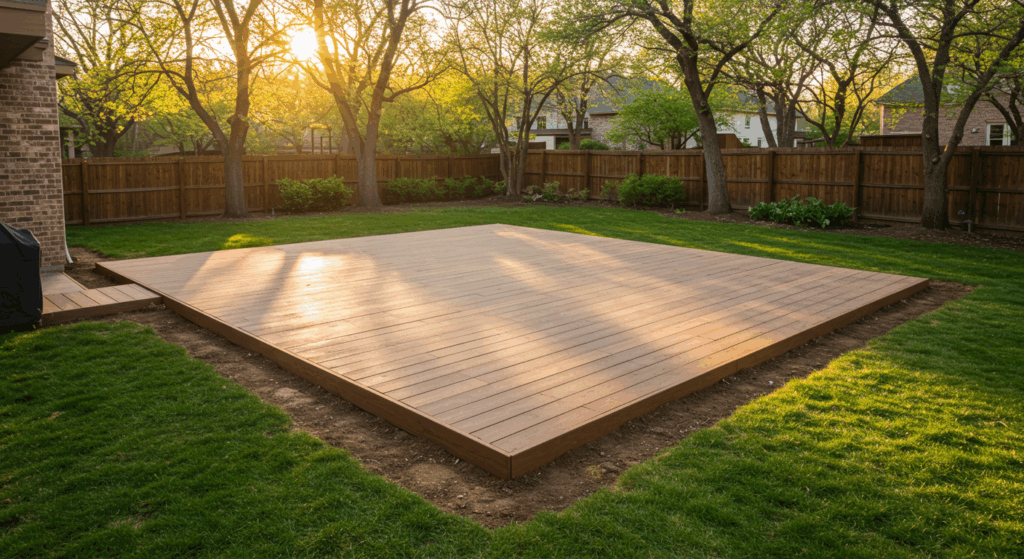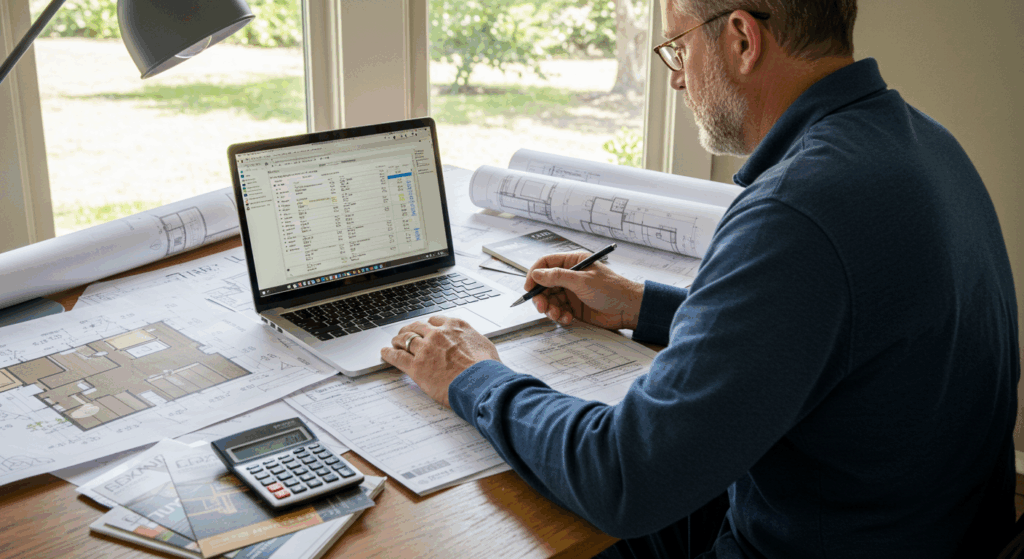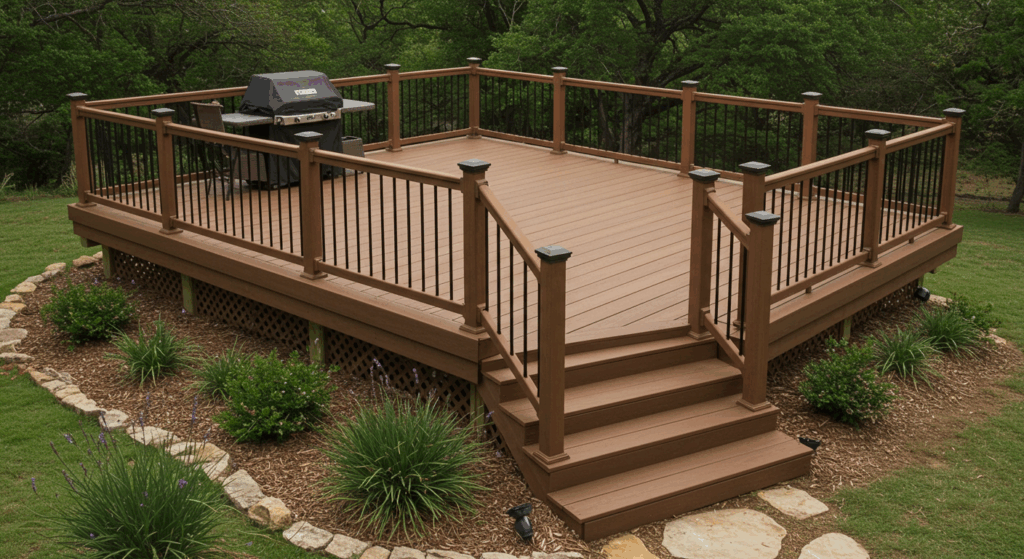When it comes to upgrading your outdoor space in Austin, whether it’s a cozy backyard deck or a private fence, one of the biggest decisions you’ll face is: should you go with traditional wood or Trex composite materials? This choice impacts not just the look of your home but its longevity, maintenance costs, environmental footprint, and even your resale value.
In this comprehensive guide, we’ll break down everything you need to know about Trex vs. traditional wood, so you can make the best decision for your Austin lifestyle.
What Is Trex?
Trex is the leading brand of composite decking and fencing materials. It’s made from a blend of 95% recycled wood fibers and plastic, creating a product that looks like natural wood but performs significantly better.
Unlike traditional lumber, Trex doesn’t splinter, rot, warp, or fade. It comes in a variety of colors and finishes, requires minimal maintenance, and is designed to withstand the harshest weather conditions — perfect for Austin’s intense sun, humidity, and seasonal storms.
Trex, a top-tier composite material, has surged in popularity among Austin homeowners thanks to its durability and eco-friendliness. But many still wonder: is it really better than traditional wood? To help you decide, we break down the differences, benefits, challenges, and long-term value of both materials — all with Austin’s unique climate and lifestyle in mind.
What Are Traditional Wood Decks and Fences?
Traditional wood materials like cedar, redwood, and pressure-treated pine have been staples in outdoor construction for decades. Many homeowners love the natural beauty and timeless feel of real wood.
However, wood comes with its own challenges: it needs regular staining or sealing, is vulnerable to rot and pests, and can fade or crack over time. Depending on the species, wood can also be more affordable up-front, though long-term costs add up due to maintenance.
Trex is a composite made from 95% recycled wood fibers and plastic, designed to mimic wood’s look without its vulnerabilities. Traditional wood options, like cedar, redwood, and pressure-treated pine, bring natural beauty but require more maintenance and come with durability concerns, especially under Austin’s intense sun and sudden downpours.
Comparing Trex and Wood: The Key Factors
| Category | Trex (Composite) | Traditional Wood |
|---|---|---|
| Material Composition | 95% recycled wood fibers + plastic | Natural wood (cedar, redwood, pressure-treated pine) |
| Durability | Resists rot, warping, splintering, and pests; lasts 25–30+ yrs | Prone to rot, splintering, insect damage; lasts 10–15 yrs (with good maintenance) |
| Weather Resistance | Withstands Austin’s intense sun, rain, humidity, and storms | Needs regular sealing to protect against weather; fades, cracks over time |
| Maintenance | Low-maintenance: occasional rinse with soap + water | High-maintenance: annual sealing, staining, painting needed |
| Appearance | Mimics wood look; consistent color + finish; wide color range | Natural beauty; customizable with stains/paints; unique grain |
| Environmental Impact | Made from recycled materials; eco-friendly | Natural, biodegradable, but logging impacts + chemical treatments |
| Safety | Slip-resistant, splinter-free, cooler underfoot (lighter colors) | Can splinter, crack, become slippery when wet |
| Customization | Multiple colors, textures, finishes; allows modern designs | Can stain, paint, shape easily; offers rustic, authentic look |
| Warranty | 25+ year fade + stain warranty (manufacturer-backed) | Typically no manufacturer warranty; depends on maintenance |
| Initial Cost | Higher upfront material + install cost | Lower upfront cost (except for exotic hardwoods) |
| Long-term cost | Lower lifetime cost (minimal upkeep, long lifespan) | Higher lifetime cost (ongoing maintenance, repairs, replacements) |
| Resale Value | Adds modern, low-maintenance appeal; boosts ROI in Austin | Adds classic charm; potential buyers may worry about upkeep |
| Best For | Busy homeowners, eco-conscious buyers, modern designs | Those who love natural wood’s charm, don’t mind regular upkeep |
Let’s break this down by what matters most to Austin homeowners.
1. Durability in Austin’s Climate
-
Trex: Built to handle extreme heat, UV exposure, and moisture without warping or fading. No termites, no mold.
-
Wood: Needs frequent sealing to protect against moisture. Prone to cracking, splintering, and fading under Austin’s hot sun. Susceptible to insect damage.
Winner: Trex — hands down, especially in Austin’s unpredictable weather.
2. Maintenance Requirements
-
Trex: Occasional rinse with soap and water. No staining, sealing, or painting required.
-
Wood: Needs annual or biannual sealing, staining, or painting. Regular inspections for rot, insect damage, and splintering.
Winner: Trex. If you want your weekends free, composite is the low-maintenance choice.
3. Aesthetic and Design Flexibility
-
Trex: Wide range of colors and finishes that mimic natural wood but stay consistent over time.
-
Wood: Natural variations in grain and color that some homeowners love. Customizable with stains and paints.
Winner: Tie — depends on personal taste. Trex offers consistency, while wood offers rustic charm.
4. Environmental Impact
-
Trex: Made from 95% recycled materials, including reclaimed wood and plastic. Helps reduce landfill waste.
-
Wood: Natural product, biodegradable, but logging impacts forests, and pressure-treated wood involves chemical processes.
Winner: Trex, especially for eco-conscious Austinites.
5. Initial Cost
-
Trex: Typically more expensive up-front, but price ranges depending on style.
-
Wood: Lower initial cost, though exotic hardwoods like Ipe can be expensive.
Winner: Wood — but only at first glance. See below.
6. Lifetime Value and Long-Term Cost
-
Trex: Lasts 25-30+ years with minimal upkeep. Lower lifetime cost when factoring in reduced maintenance.
-
Wood: Lifespan of 10-15 years (if well-maintained). Ongoing maintenance costs add up significantly over time.
Winner: Trex, especially for homeowners who plan to stay put and want a long-term investment.
7. Resale and Property Value
-
Trex: Adds modern appeal, low-maintenance promise, and long-lasting value to listings.
-
Wood: Adds classic charm but can signal high upkeep to potential buyers.
Winner: Trex, particularly with Austin’s growing demand for eco-friendly, low-maintenance homes.
Real-Life Examples: Trex vs. Wood in Austin Homes
Example 1: East Austin Bungalow
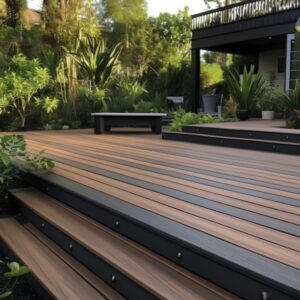
A young couple wanted a stylish, modern deck to host weekend gatherings. They chose Trex in a sleek gray tone. Five years later, it still looks brand new, despite constant use, BBQ spills, and Texas sun. Their neighbors, who built a cedar deck around the same time, are now dealing with fading, splintering boards, and rising maintenance costs.
Example 2: Hill Country Ranch
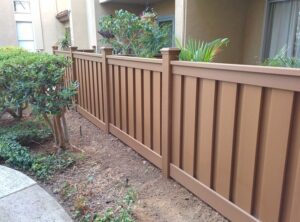
A family with a large property installed a classic cedar fence to blend with the natural landscape. While it looked beautiful initially, they now face annual staining, pest treatments, and some sections showing rot. They are considering switching to Trex for better long-term performance and less hassle.
Example 3: Urban Backyard
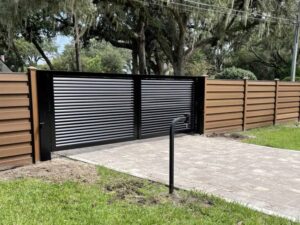
A busy professional in downtown Austin wanted a low-fuss backyard upgrade. Trex fencing provided clean lines, privacy, and minimal upkeep. Their neighbors are surprised at how natural it looks — and envious they don’t have to spend weekends repainting.
Common Myths About Trex
Myth 1: Trex Looks Fake
Reality: Modern Trex products have realistic grain patterns and rich colors. Most people can’t tell the difference without a close-up inspection.
Myth 2: Trex Gets Too Hot in the Sun
Reality: All decking materials (including wood) get warm in direct sunlight. Trex’s lighter colors stay cooler, and using shade features like pergolas helps.
Myth 3: Trex Is Only for Big Budgets
Reality: While the initial investment is higher, the long-term savings make it cost-effective. Plus, financing options make it accessible.
Which Should You Choose?
Ask yourself these questions:
-
Do you want low maintenance or are you okay with regular upkeep?
-
Is long-term durability more important, or are you okay with replacing your deck or fence in 10-15 years?
-
Do you prioritize eco-friendly materials?
-
Are you after a consistent look or do you love the natural imperfections of wood?
For most Austin homeowners, Trex wins on durability, maintenance, environmental impact, and lifetime value. Traditional wood might still appeal to those who love its authentic charm and don’t mind the ongoing care.
What Makes Trex Perfect for Austin?
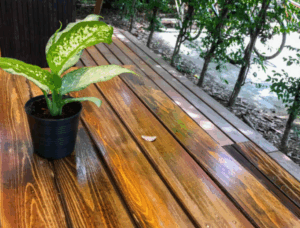
Austin’s intense sun, humidity swings, and occasional storms mean outdoor materials get tested hard. Trex was engineered for these exact conditions — resisting UV damage, moisture, mold, and pests. With the city’s eco-conscious vibe, Trex’s recycled materials are a perfect fit. And with busy Austin lifestyles, its low-maintenance nature frees up your time to enjoy your space, not fix it.
Ask any Austin homeowner with a wood deck: maintenance is a chore. Annual sealing, staining, or painting is essential to keep wood protected. With Trex, maintenance is as simple as a periodic rinse. No sanding, no sealing — just lasting beauty with minimal effort. This lower upkeep appeals especially to busy families and retirees who want to enjoy their backyard, not spend weekends working on it.
Trex is a green builder’s dream. Its composite makeup repurposes plastic bags and wood scraps, diverting waste from landfills. Traditional wood, though renewable, often comes from virgin timber, and the treatments required for longevity introduce chemicals into your space. For eco-conscious Austinites, Trex offers peace of mind and environmental stewardship.
Let’s be honest: natural wood has a timeless charm. Its grain, knots, and organic warmth are hard to replicate. That said, Trex has come a long way in mimicking wood’s beauty, offering a wide palette of colors and finishes that hold up over decades. Unlike wood, Trex’s color won’t fade to gray or require touch-ups, so the style you choose is the style you keep.
Trex costs more upfront — no sugarcoating it. Composite materials are priced higher than most wood options, and installation can sometimes be more involved due to specific framing or fastening systems. But when you factor in the long-term savings on maintenance, repair, and replacement, many homeowners find Trex pays for itself over time.
Also Read: How Trex Installations Are Built for Austin’s Unique Landscape
Safety & Comfort
Trex’s composite surface is splinter-free and slip-resistant, making it a safer option for families, pets, and barefoot lounging. Wood, on the other hand, can develop splinters or slick spots, especially when wet. Austin homes with pools or frequent backyard parties often benefit from Trex’s superior comfort and safety features.
Also, Trex typically comes with a 25-year or longer warranty, covering fading, staining, and structural integrity. Most wood options, by contrast, have no manufacturer’s warranty — once installed, it’s up to the homeowner to maintain and replace. Having the peace of mind of a long-term guarantee is a major advantage, especially in Austin’s unpredictable climate.
Resale Value Over Time
Adding a new deck or fence boosts curb appeal and resale value — but which material gives you the edge? Trex’s long lifespan, warranty, and low-maintenance appeal are big selling points for buyers. While wood can charm buyers seeking authenticity, many are wary of the upkeep. If you plan to sell your Austin home in the next decade, Trex may offer a stronger ROI.
Beyond your own backyard, the choice between Trex and wood can affect neighborhood aesthetics and home value. Trex’s long-lasting, uniform appearance helps maintain a tidy, upscale look that can enhance entire streetscapes. Wood, while beautiful when fresh, can deteriorate quickly if neglected, pulling down visual appeal and potentially impacting resale prices in competitive Austin markets.
While wood may seem more budget-friendly initially, the ongoing costs for upkeep, repairs, and eventual replacement add up. Trex’s higher upfront cost levels out across its 25–30+ year lifespan. For homeowners planning to stay put, it’s often the more economical choice over the long haul.
Austin’s environment isn’t just hot — it’s wildly variable. From scorching sun to hailstorms, the city tests any outdoor material. Trex’s resistance to fading, cracking, and water damage makes it particularly well-suited for the Hill Country climate, where weather swings can devastate untreated or under-maintained wood structures.
Check This Out: 7 Powerful Ways a Trex Deck or Fence Instantly Boosts Your Home’s Value
Trex for Poolside & Outdoor Entertaining Spaces
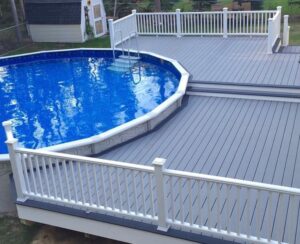
Austin homes often feature backyard pools, outdoor kitchens, and large entertainment spaces. Trex shines in these areas because it resists water, won’t develop mildew, and stays cool underfoot compared to many wood surfaces. Families with children or pets appreciate Trex’s slip resistance and the fact that composite materials don’t splinter or crack with exposure to chlorine or outdoor cooking heat.
One more thing about Trex is that it offers a wide variety of colors, textures, and finishes that allow homeowners to tailor their decks and fences to match any architectural style, from sleek modern to rustic farmhouse. With Trex, you can mix colors, add integrated lighting, or use custom shapes and layouts that traditional wood might struggle to accommodate without warping or cracking. Choosing between Trex vs. traditional wood is no brainer really! Trex design flexibility helps homeowners create outdoor spaces that feel truly personal and unique, choosing wood simply means embracing rigidity.
The Bottom Line — Trex vs. Traditional Wood:?
Ultimately, when it comes to the battle of Trex vs. traditional wood, the best material for your Austin home depends on your budget, lifestyle, and long-term plans. If you prioritize natural beauty, a lower upfront cost, and don’t mind regular maintenance, traditional wood may suit you. But if you want durability, sustainability, minimal upkeep, and a sleek modern aesthetic, Trex is hard to beat. For most Austin homeowners, Trex offers a winning combination of form, function, and future-proof value.
The best part? Our team offers professional deck installation in Austin, whether you choose Trex or traditional wood, we’ve got you!
Partner With AHY for Your Trex Project

At AHY, your expert Austin outdoor contractors, we help homeowners make the right material choice. We specialize in Trex deck and fence installation, replacement, and inspection in Austin. Our team knows the local landscape, climate, and design trends. We’re committed to helping you choose the best materials for your needs and delivering expert craftsmanship that lasts.
From small backyard decks to sprawling Hill Country fences, we bring the tools, the talent, and the passion to make your outdoor dreams real — with Trex that’s built for Austin.
Deck aside, even for fences, AHY’s trusted Austin fence installation experts ensure top-quality materials and craftsmanship. We’re your one-stop, get the perfect outdoor space.
To learn more about our Austin-based team and what drives us, visit our About Us page.
Ready to Explore Trex?
Get a Free Estimate || See Our Trex Portfolio
Call us today or fill out our quick online form. Let’s bring your backyard vision to life, the Trex way.
Fun Fact: Did you know Trex has been around for over 25 years and is the world’s #1 decking brand? That’s the kind of reliability you want backing your Austin home upgrade.

